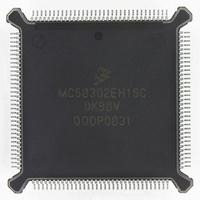MC68302EH16C Freescale Semiconductor, MC68302EH16C Datasheet - Page 225

MC68302EH16C
Manufacturer Part Number
MC68302EH16C
Description
IC MPU MULTI-PROTOCOL 132-PQFP
Manufacturer
Freescale Semiconductor
Datasheets
1.MC68302AG20C.pdf
(4 pages)
2.MC68302AG20C.pdf
(2 pages)
3.MC68302AG20C.pdf
(13 pages)
4.MC68302EH16C.pdf
(481 pages)
Specifications of MC68302EH16C
Processor Type
M683xx 32-Bit
Speed
16MHz
Voltage
5V
Mounting Type
Surface Mount
Package / Case
132-MQFP, 132-PQFP
Controller Family/series
68K
Core Size
32 Bit
Ram Memory Size
1152Byte
Cpu Speed
16MHz
No. Of Timers
3
Embedded Interface Type
SCP, TDM
Digital Ic Case Style
PQFP
Rohs Compliant
Yes
Family Name
M68000
Device Core
ColdFire
Device Core Size
32b
Frequency (max)
16MHz
Instruction Set Architecture
RISC
Supply Voltage 1 (typ)
5V
Operating Temp Range
0C to 70C
Operating Temperature Classification
Commercial
Mounting
Surface Mount
Pin Count
132
Package Type
PQFP
Lead Free Status / RoHS Status
Lead free / RoHS Compliant
Features
-
Lead Free Status / Rohs Status
RoHS Compliant part
Electrostatic Device
Available stocks
Company
Part Number
Manufacturer
Quantity
Price
Company:
Part Number:
MC68302EH16C
Manufacturer:
Freescale Semiconductor
Quantity:
135
Company:
Part Number:
MC68302EH16C
Manufacturer:
PANA
Quantity:
99
Company:
Part Number:
MC68302EH16C
Manufacturer:
Freescale Semiconductor
Quantity:
10 000
Part Number:
MC68302EH16C
Manufacturer:
FREESCALE
Quantity:
20 000
Company:
Part Number:
MC68302EH16CB1
Manufacturer:
Freescale Semiconductor
Quantity:
10 000
Company:
Part Number:
MC68302EH16CR2
Manufacturer:
Freescale Semiconductor
Quantity:
10 000
- MC68302AG20C PDF datasheet
- MC68302AG20C PDF datasheet #2
- MC68302AG20C PDF datasheet #3
- MC68302EH16C PDF datasheet #4
- Current page: 225 of 481
- Download datasheet (2Mb)
RESTART TRANSMIT Command
If the channel is being re-enabled, the RESTART TRANSMIT command must be used and
should be followed by the enabling of the transmitter in the SCC mode register.
ENTER HUNT MODE Command
4.5.14.6 DDCMP Control Character Recognition
The DDCMP controller can recognize three special control characters. These characters are
used to synchronize the message and allow the DDCMP controller to function in a DMA-con-
trolled environment.
DSYN1—DDCMP Sync Character Register
MOTOROLA
transmission, message transmission is aborted after the contents of the FIFO (up to three
bytes) are transmitted. The TBD# is not advanced. No new BD is accessed, and no new
messages are transmitted for this channel. Upon receipt of this command, the transmitter
aborts the message transmission (if currently transmitting) and then transmits SYN1–
SYN2 pairs or IDLEs as determined by the DDCMP mode register.
The STOP TRANSMIT command must be issued before the SCC mode register is used
to disable the transmitter if the transmitter is to be re-enabled at a later time.
The RESTART TRANSMIT command re-enables the transmission of characters on the
transmit channel. This command is expected by the DDCMP controller after a STOP
TRANSMIT command, after a STOP TRANSMIT command followed by the disabling of
the channel in its SCC mode register, or after a transmitter error (underrun or CTS lost
during data or maintenance message header fields). The DDCMP controller will resume
transmission from the current transmitter BD number (TBD#) in the channel's transmit BD
table.
After a hardware or software reset and the enabling of the channel in the SCC mode reg-
ister, the channel is in the receive enable mode and will use the first BD in the table.
The ENTER HUNT MODE command is used to force the DDCMP controller to abort re-
ception of the current message, generate an RBD interrupt (if enabled) as the buffer is
closed, and enter hunt mode. In hunt mode, the DDCMP controller continually scans the
input data stream for the SYN1–SYN2 sequence on synchronous links. Then for synchro-
nous or asynchronous links, the DDCMP controller scans the input bytes for the starting
byte of one of the messages. After receiving the command, the current receive buffer is
closed, and the CRC is reset. Message reception continues using the next BD.
If an enabled receiver has been disabled (by clearing ENR in the SCC mode register), the
ENTER HUNT MODE command must be given to the channel before setting ENR again.
The 8-bit DSYN1 register should be written with the same value that was written in the
SYN1 byte of the data synchronization register (DSR). DSYN1 is a memory-mapped
read-write register.
For correct operation of DDCMP, DSYN1, SYN1, and SYN2
must be the same value.
MC68302 USER’S MANUAL
NOTE
Communications Processor (CP)
4-105
Related parts for MC68302EH16C
Image
Part Number
Description
Manufacturer
Datasheet
Request
R
Part Number:
Description:
Manufacturer:
Freescale Semiconductor, Inc
Datasheet:

Part Number:
Description:
MC68302 Configuring the Chip Selects on the MC68302
Manufacturer:
Motorola / Freescale Semiconductor

Part Number:
Description:
MC68302 Design Concept - Expanding Interrupts on the MC68302
Manufacturer:
Motorola / Freescale Semiconductor

Part Number:
Description:
MC68302 MC68302 Adapting a WAN Controller to a LAN Environment
Manufacturer:
Motorola / Freescale Semiconductor

Part Number:
Description:
MC68302 EKB Applications - Power Measurements on the MC68302
Manufacturer:
Motorola / Freescale Semiconductor

Part Number:
Description:
MC68302 Interfacing the MC68020 to a Slave MC68302
Manufacturer:
Motorola / Freescale Semiconductor

Part Number:
Description:
MC68302 MC68302 Software Performance
Manufacturer:
Motorola / Freescale Semiconductor

Part Number:
Description:
MC68302 Evaluating EDX on the ADS302
Manufacturer:
Motorola / Freescale Semiconductor

Part Number:
Description:
MC68302 Design Advisory #1 - MC68SC302 Passive ISDN Protocol Engine
Manufacturer:
Motorola / Freescale Semiconductor

Part Number:
Description:
MC68302, MC68360, and MPC860 Characteristics and Design Notes for Crystal Feedback Oscillators
Manufacturer:
Motorola / Freescale Semiconductor
Part Number:
Description:
Mc68302 Integrated Multi-protocol Processor
Manufacturer:
Freescale Semiconductor, Inc
Datasheet:
Part Number:
Description:
Manufacturer:
Freescale Semiconductor, Inc
Datasheet:
Part Number:
Description:
Manufacturer:
Freescale Semiconductor, Inc
Datasheet:
Part Number:
Description:
Manufacturer:
Freescale Semiconductor, Inc
Datasheet:
Part Number:
Description:
Manufacturer:
Freescale Semiconductor, Inc
Datasheet:











